 1
1 A South Vietnamese soldier holds a cocked pistol as he questions two suspected Viet Cong guerrillas captured in a weed-filled marsh in the southern delta region late in August 1962. The prisoners were searched, bound and questioned before being marched off to join other detainees. (AP Photo/Horst Faas)
Photo by Add this to feed 2
2 A U.S. crewman runs from a crashed CH-21 Shawnee troop helicopter near the village of Ca Mau in the southern tip of South Vietnam, Dec. 11, 1962. Two helicopters crashed without serious injuries during a government raid on the Viet Cong-infiltrated area. Both helicopters were destroyed to keep them out of enemy hands. (AP Photo/Horst Faas)
Photo by Add this to feed 3
3 3A Helmeted U.S. Helicopter Crewchief, holding carbine, watches ground movements of Vietnamese troops from above during a strike against Viet Cong Guerrillas in the Mekong Delta Area, January 2, 1963. The communist Viet Cong claimed victory in the continuing struggle in Vietnam after they shot down five U.S. helicopters. An American officer was killed and three other American servicemen were injured in the action. (AP Photo)
Photo by Add this to feed 4
4 Caskets containing the bodies of seven American helicopter crewmen killed in a crash on January 11, 1963 were loaded aboard a plane on
Monday, Jan. 14 for shipment home. The crewmen were on board a H21 helicopter that crashed near a hut on an Island in the middle of one of the branches of the Mekong River, about 55 miles Southwest of Saigon. (AP Photo)
Photo by Add this to feed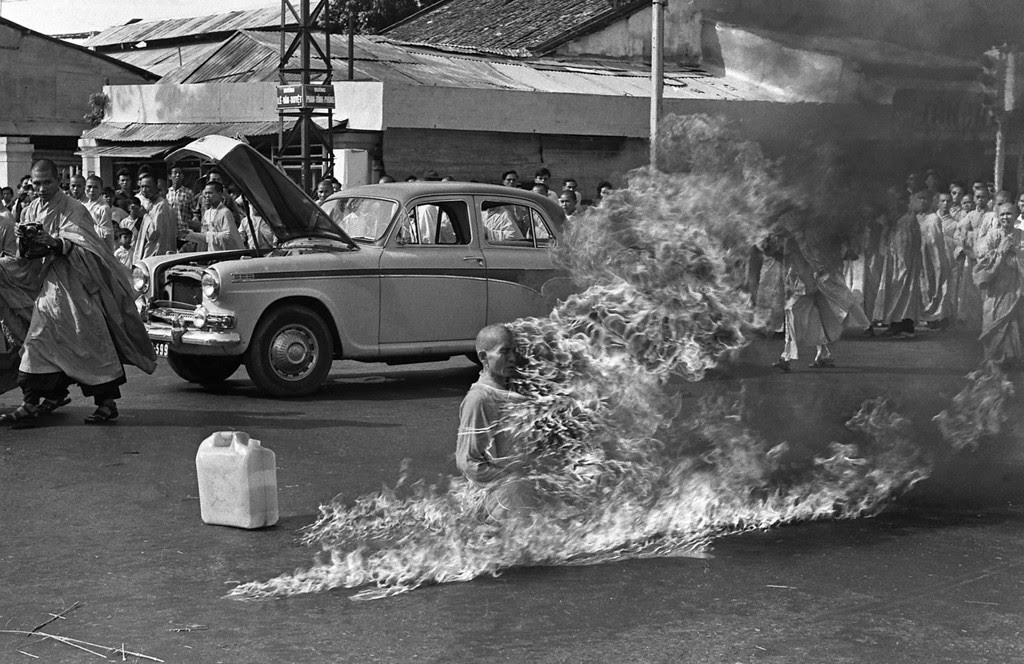 5
5 Quang Duc, a Buddhist monk, burns himself to death on a Saigon street on June 11, 1963, to protest alleged persecution of Buddhists by the South Vietnamese government. (AP Photo/Malcolm Browne, File)
Photo by Add this to feed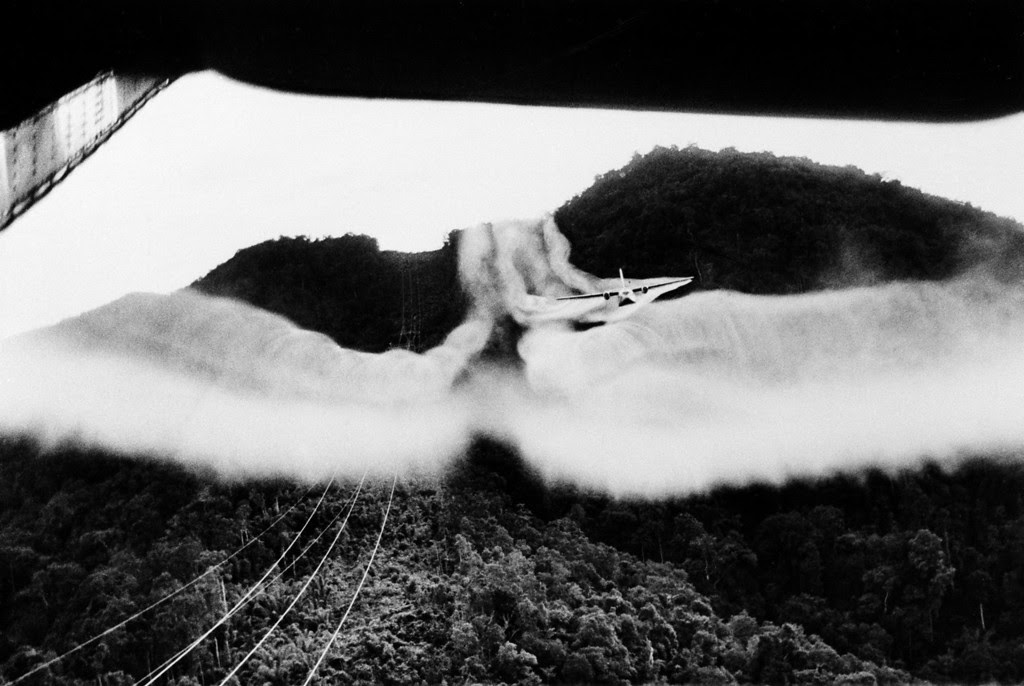 6
6 Flying at dawn, just over the jungle foliage, U.S. C-123 aircraft spray concentrated defoliant along power lines running between Saigon and Dalat in South Vietnam, early in August 1963. The planes were flying about 130 miles per hour over steep, hilly terrain, much of it believed infiltrated by the Viet Cong. (AP Photo/Horst Faas)
Photo by Add this to feed 7
7 A South Vietnamese Marine, severely wounded in a Viet Cong ambush, is comforted by a comrade in a sugar cane field at Duc Hoa, about 12 miles from Saigon, Aug. 5, 1963. A platoon of 30 Vietnamese Marines was searching for communist guerrillas when a long burst of automatic fire killed one Marine and wounded four others. (AP Photo/Horst Faas)
Photo by Add this to feed 8
8 A father holds the body of his child as South Vietnamese Army Rangers look down from their armored vehicle March 19, 1964. The child was killed as government forces pursued guerrillas into a village near the Cambodian border. (AP Photo/Horst Faas)
Photo by Add this to feed 9
9 General William Westmoreland talks with troops of first battalion, 16th regiment of 2nd brigade of U.S. First Division at their positions near Bien Hoa in Vietnam, 1965. (AP Photo)
Photo by Add this to feed 10
10 The sun breaks through the dense jungle foliage around the embattled town of Binh Gia, 40 miles east of Saigon, in early January 1965, as South Vietnamese troops, joined by U.S. advisors, rest after a cold, damp and tense night of waiting in an ambush position for a Viet Cong attack that didn't come.
One hour later, as the possibility of an overnight attack by the Viet Cong diasappeared, the troops moved out for another long, hot day hunting the elusive communist guerrillas in the jungles. (AP Photo/Horst Faas)
Photo by Add this to feed 11
11 Hovering U.S. Army helicopters pour machine gun fire into a tree line to cover the advance of South Vietnamese ground troops in an attack on a Viet Cong camp 18 miles north of Tay Ninh, northwest of Saigon near the Cambodian border, in Vietnam in March of 1965. (AP Photo/Horst Faas, File)
Photo by Add this to feed 12
12 Injured Vietnamese receive aid as they lie on the street after a bomb explosion outside the U.S. Embassy in Saigon, Vietnam, March 30, 1965. Smoke rises from wreckage in the background. At least two Americans and several Vietnamese were killed in the bombing. (AP Photo/Horst Faas)
Photo by Add this to feed 13
13 Capt. Donald R. Brown of Annapolis, Md., advisor to the 2nd Battalion of the 46th Vietnamese regiment, dashes from his helicopter to the cover of a rice paddy dike during an attack on Viet Cong in an area 15 miles west of Saigon on April 4, 1965 during the Vietnam War. Brown's counterpart, Capt. Di, commander of the unit, rushes away in background with his radioman. The Vietnamese suffered 12 casualties before the field was taken. (AP Photo/Horst Faas)
Photo by Add this to feed 14
14 U.S. soldiers are on the search for Viet Cong hideouts in a swampy jungle creek bed, June 6, 1965, at Chutes de Trian, some 40 miles northeast of Saigon, South Vietnam. (AP Photo/Horst Faas)
Photo by Add this to feed 15
15 The strain of battle for Dong Xoai is shown on the face of U.S. Army Sgt. Philip Fink, an advisor to the 52nd Vietnamese Ranger battalion, shown June 12, 1965. The unit bore the brunt of recapturing the jungle outpost from the Viet Cong. (AP Photo/Steve Stibbens)
Photo by Add this to feed 16
16 An unidentified U.S. Army soldier wears a hand lettered "War Is Hell" slogan on his helmet, in Vietnam on June 18, 1965. (AP Photo/Horst Faas, File)
Photo by Add this to feed 17
17 South Vietnamese supply trucks take a detour around a destroyed bridge en route to Pleiku on Route 19, July 18, 1965. The original bridge, and a temporary bridge placed on top of it, were both destroyed by the Viet Cong. (AP Photo/Eddie Adams)
Photo by Add this to feed 18
18 Wounded marines lie about the floor of a H34 helicopter, August 19, 1965 as they were evacuated from the battle area on Van Tuong peninsula. (AP Photo)
Photo by Add this to feed 19
19 The Associated Press photographer Huynh Thanh My covers a Vietnamese battalion pinned down in a Mekong Delta rice paddy about a month before he was killed in combat on Oct. 10, 1965. (AP PHOTO)
Photo by Add this to feed 20
20 Elements of the U.S. First Cavalry Air Mobile division in a landing craft approach the beach at Qui Nhon, 260 miles northeast of Saigon, Vietnam, in Sept. 1965. Advance units of 20,000 new troops are being launched for a strike on the Viet Cong during the Vietnam War. (AP Photo)
Photo by Add this to feed 21
21 Paratroopers of the U.S. 2nd Battalion, 173rd Airborne Brigade hold their automatic weapons above water as they cross a river in the rain during a search for Viet Cong positions in the jungle area of Ben Cat, South Vietnam, Sept. 25,1965. The paratroopers had been searching the area for 12 days with no enemy contact. (AP Photo/Henri Huet)
Photo by Add this to feed 22
22 Wounded U.S. paratroopers are helped by fellow soldiers to a medical evacuation helicopter on Oct. 5, 1965 during the Vietnam War. Paratroopers of the 173rd Airborne Brigade's First Battalion suffered many casualties in the clash with Viet Cong guerrillas in the jungle of South Vietnam's "D" Zone, 25 miles Northeast of Saigon. (AP Photo)
Photo by Add this to feed 23
23 College students carrying pro-American signs heckle anti-war student demonstrators protesting U.S. involvement in Vietnam at the Boston Common in Boston, Ma., Oct. 16, 1965. (AP Photo)
Photo by Add this to feed 24
24 A U.S. B-52 stratofortress drops a load of 750-pounds bombs over a Vietnam coastal area during the Vietnam War, Nov. 5, 1965. (AP Photo/USAF)
Photo by Add this to feed 25
25 Chaplain John McNamara of Boston makes the sign of the cross as he administers the last rites to photographer Dickey Chapelle in South Vietnam Nov. 4, 1965. Chapelle was covering a U.S. Marine unit on a combat operation near Chu Lai for the National Observer when she was seriously wounded, along with four Marines, by an exploding mine. She died in a helicopter en route to a hospital. She became the first female war correspondent to be killed in Vietnam, as well as the first American female reporter to be killed in action. Her body was repatriated with an honor guard consisting of six Marines and she was given full Marine burial. (AP Photo/Henri Huet)
Photo by Add this to feed 26
26 Berkeley-Oakland City, Calif. demonstraters march against the war in Vietnam, December 1965. Calif. (AP Photo)
Photo by Add this to feed 27
27 A napalm strike erupts in a fireball near U.S. troops on patrol in South Vietnam, 1966 during the Vietnam War. (AP Photo)
Photo by Add this to feed 28
28 A U.S. paratrooper moves away after setting fire to house on bank of the Vaico Oriental River, 20 miles west of Saigon on Jan. 4, 1966, during a "scorched earth" operation against the Viet Cong in South Viet Nam. The 1st battalion of the 173rd airborne brigade was moving through the area, described as notorious Viet Cong territory. (AP Photo/Peter Arnett)
Photo by Add this to feed 29
29 Women and children crouch in a muddy canal as they take cover from intense Viet Cong fire at Bao Trai in Jan. of 1966, about 20 miles west of Saigon, Vietnam. (AP Photo/Horst Faas, File)
Photo by Add this to feed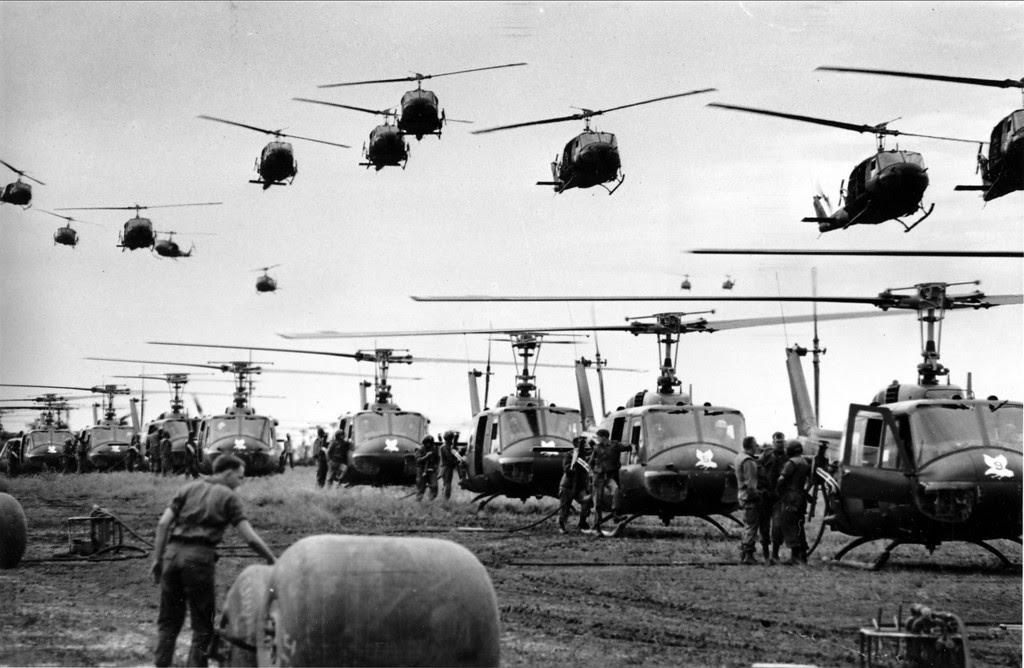 30
30 U.S. Army helicopters providing support for U.S. ground troops fly into a staging area fifty miles northeast of Saigon, Vietnam in January of 1966. (AP Photo/Henri Huet, File)
Photo by Add this to feed 31
31 First Cavalry Division Medic Thomas Cole, from Richmond, Va., looks up with his one uncovered eye as he continues to treat a wounded Staff Sgt. Harrison Pell during a January 1966 firefight in the Central Highlands between U.S. troops and a combined North Vietnamese and Vietcong force. (AP Photo/Henri Huet)
Photo by Add this to feed 32
32 Weary after a third night of fighting against North Vietnamese troops, U.S. Marines crawl from foxholes located south of the demilitarized zone (DMZ) in Vietnam, 1966. The helicopter at left was shot down when it came in to resupply the unit. (AP Photo/Henri Huet)
Photo by Add this to feed 33
33 Water-filled bomb craters from B-52 strikes against the Viet Cong mark the rice paddies and orchards west of Saigon, Vietnam, 1966. Most of the area had been abandoned by the peasants who used to farm on the land. (AP Photo/Henri Huet)
Photo by Add this to feed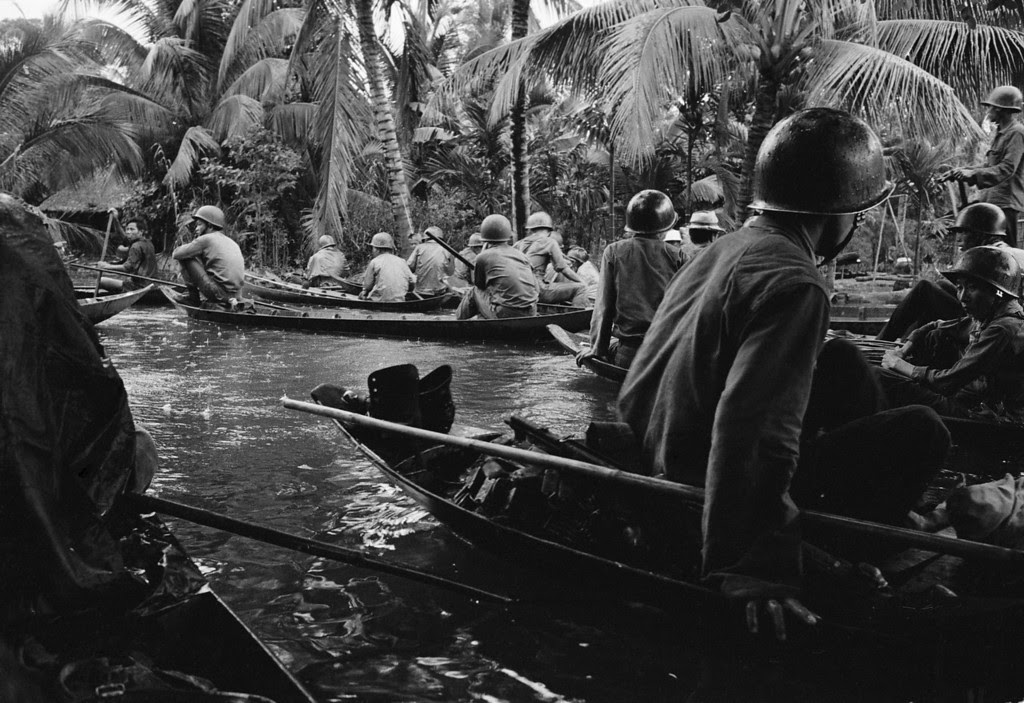 34
34 In a sudden monsoon rain, part of a company of about 130 South Vietnamese regional soldiers moves downriver in sampans during a dawn attack against a Viet Cong camp in the flooded Mekong Delta, about 13 miles northeast of Cantho, on Jan. 10, 1966. A handful of guerrillas were reported killed or wounded. (AP Photo/Henri Huet)
Photo by Add this to feed 35
35 Pfc. Lacey Skinner of Birmingham, Ala., crawls through the mud of a rice paddy in January of 1966, avoiding heavy Viet Cong fire near An Thi in South Vietnam, as troops of the U.S. 1st Cavalry Division fight a fierce 24-hour battle along the central coast. (AP Photo/Henri Huet)
Photo by Add this to feed 36
36 President Lyndon Johnson speaks during a televised address from the White House, Jan. 31, 1966, announcing the resumption of bombing of targets in North Vietnam. The president, who was photographed from a television screen at the New York studios of NBC-TV, said he was requesting Amb. Arthur Goldberg to call for an immediate meeting of the U.N. Security Council. (AP Photo/Marty Lederhandler)
Photo by Add this to feed 37
37 U.S. troops carry the body of a fellow soldier across a rice paddy for helicopter evacuation near Bong Son in early February 1966. The soldier, a member of the 1st Air Cavalry Division, was killed during Operation Masher on South Vietnam's central coast. (AP Photo/Rick Merron)
Photo by Add this to feed 38
38 A helicopter lifts a wounded American soldier on a stretcher during Operation Silver City in Vietnam, March 13, 1966. (AP Photo)
Photo by Add this to feed 39
39 Seen here are pickets demonstrating against the Vietnam War as they march through downtown Philadelphia, Pa, March, 26 1966. (AP Photo/Bill Ingraham)
Photo by Add this to feed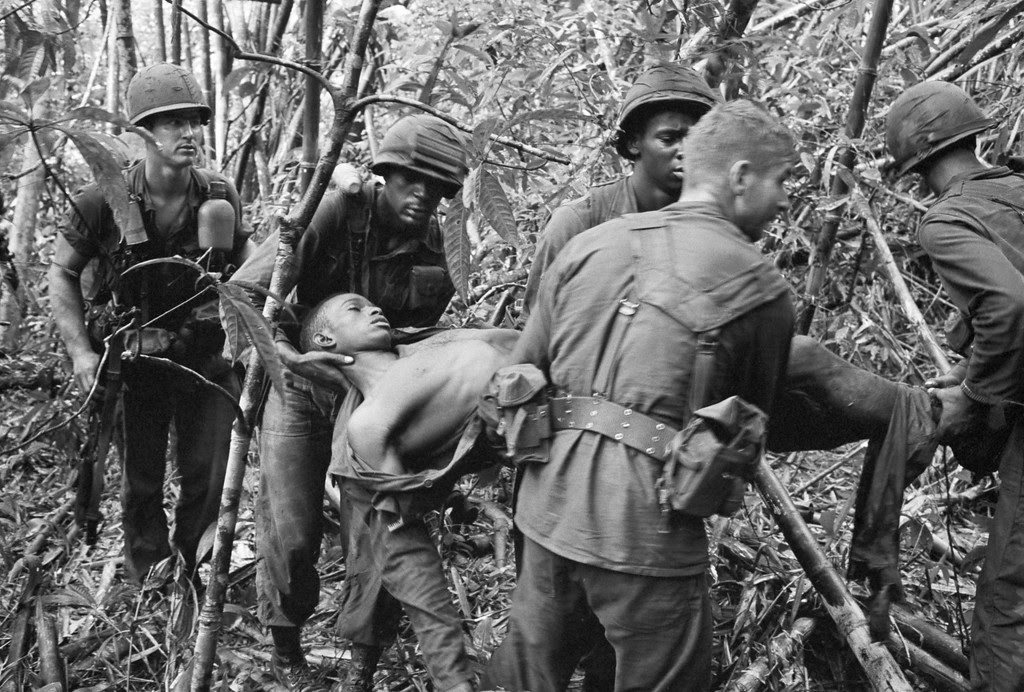 40
40 Soldiers of the 101st Airborne Division carry a wounded buddy through the jungle in May 1966. (AP Photo/Henri Huet)
Photo by Add this to feed 41
41 A helicopter hovers over the field, ready to load personnel and equipment during Operation Masher in the Vietnam War, May 7, 1966. (AP Photo)
Photo by Add this to feed 42
42 A young paratrooper with a mud-smeared face stares into the jungle in Vietnam on July 14, 1966, after fire fight with Viet Cong patrol in the morning. He is a member of C company, 2nd battalion, 173rd airborne brigade. (AP Photo/John Nance)
Photo by Add this to feed 43
43 A U.S. Marine CH-46 Sea Knight helicopter comes down in flames after being hit by enemy ground fire during Operation Hastings, just south of the Demilitarized Zone between North and South Vietnam, July 15, 1966. The helicopter crashed and exploded on a hill, killing one crewman and 12 Marines. Three crewman escaped with serious burns. (AP Photo/Horst Faas)
Photo by Add this to feed 44
44 Pinned down by Viet Cong machine gun fire, a U.S. medic looks over at a seriuosly wounded comrade as they huddle behind a dike in a rice paddy, near Phu Loi, South Vietnam, August 14, 1966. (AP Photo)
Photo by Add this to feed 45
45 A U.S. infantryman from A Company, 1st Battalion, 16th Infantry carries a crying child from Cam Xe village after dropping a phosphorous grenade into a bunker cleared of civilians during an operation near the Michelin rubber plantation northwest of Saigon, August 22, 1966. A platoon of the 1st Infantry Division raided the village, looking for snipers that had inflicted casualties on the platoon. GIs rushed about 40 civilians out of the village before artillery bombardment ensued. (AP Photo/Horst Faas)
Photo by Add this to feed 46
46 An American F-105 warplane is shot down and the pilot ejects and opens his parachute in this photo taken by North Vietnamese photograper Mai Nam on September 1966 near Vinh Phuc, north of Hanoi. This photo is one of the most recognized images taken by a North Vietnamese photographer during the war. The pilot of the aircraft was taken hostage and held in a Hanoi prison from 1966 to 1973. (AP Photo/Pioneer Newspaper/Mai Nam)
Photo by Add this to feed 47
47 Paratroopers of the 173rd U.S. airborne brigade make their way across the Song Be River in South Vietnam en route to the jungle on the North Bank and into operation Sioux City in the D Zone on Oct. 4, 1966. Troopers and equipment were flown in by helicopter to the central highlands area, but the choppers couldn't land in the D zone jungles. The operation began late in the week of
September 25. (AP Photo)
Photo by Add this to feed 48
48 U.S. President Lydon B. Johnson reviews troops assembled in honor of his visit to the U.S. base at Cam Ranh Bay in South Vietnam on Oct. 26, 1966 during the war. Beside the President is Gen. William Westmoreland, Commander of the U.S. Military forces in Vietnam. (AP Photo)
Photo by Add this to feed 49
49 Empty artillery cartridges pile up at the artillery base at Soui Da, some 60 miles northwest of Saigon, at the southern edge of War Zone C, on March 8, 1967. (AP Photo/Horst Faas)
Photo by Add this to feed 50
50 Three American marines sleep atop ammunition boxes during a pause in the fighting at Gio Linh on April 2, 1967, just south of the demilitarized zone in Vietnam. (AP Photo)
Photo by Add this to feed 51
51 A wounded U.S. soldier of the 1st Infantry Division, 26th Infantry Regiment, 1st Battalion, receives first aid after being rescued from a jungle battlefield south of the Cambodian border in Vietnam's war zone C, April 2, 1967. A reconnaissance platoon ran into enemy bunkers, and their recuers were pinned down for four hours in fighting that left 7 U.S. dead and 42 wounded. (AP Photo)
Photo by Add this to feed 52
52 Anti-Vietnam war demonstrators fill Fulton Street in San Francisco on April 15, 1967. The five-mile march through the city would end with a peace rally at Kezar Stadium. In the background is San Francisco City Hall. (AP Photo)
Photo by Add this to feed 53
53 Rev. Dr. Martin Luther King Jr., leads a crowd of 125,000 Vietnam War protesters in front of the United Nations in New York on April 15, 1967, as he voices a repeated demand to "Stop the bombing." (AP Photo)
Photo by Add this to feed 54
54 A U.S. Marine sergeant points directions to a group of newly arrived replacement soldiers atop embattled Hill 881, below the demilitarized zone near the Laotian border, South Vietnam, in May 1967. The men were flown in by helicopter to enforce U.S. Marine lines badly weakened by casualties after several days of fighting for the strategic hills. (AP Photo)
Photo by Add this to feed 55
55 A wounded member of the 1st Plt. Company "C," 25th Infantry Division, is helped to a waiting UH-1D "Iroquois" helicopter in Vietnam, May 10, 1967, during the Vietnam War. (AP Photo)
Photo by Add this to feed 56
56 U.S. Marines of the 3rd Battallion, 4th Marines, crouch in the cover of a pagoda entrance as their patrol moves through a village along the Ben Hai river in the southern sector of the DMZ in South Vietnam, on May 22, 1967. The pagoda walls are richly decorated with images of dragons and snakes. (AP Photo/Kim Ki Sam)
Photo by Add this to feed 57
57 American infantrymen crowd into a mud-filled bomb crater and look up at tall jungle trees seeking out Viet Cong snipers firing at them during a battle in Phuoc Vinh, north-Northeast of Saigon in Vietnam's War Zone D on June 15, 1967. (AP Photo/Henri Huet, File)
Photo by Add this to feed 58
58 Medic James E. Callahan of Pittsfield, Mass., gives mouth-to-mouth resuscitation to a dying soldier in war zone D, about 50 miles northeast of Saigon, June 17, 1967. Thirty-one men of the 1st Infantry Division were reported killed in the guerrilla ambush, with more than 100 wounded. (AP Photo/Henri Huet)
Photo by Add this to feed 59
59 Secretary of Defense Robert S. McNamara (second from left), and Gen Earle Wheeler, chairman of the Joint Chiefs of Staff, huddle in one corner while Ellsworth Bunker, U.S. Ambassador to South Vietnam (second from right), and Gen. William C. Westmoreland, right, commander of U.S. Forces in Vietnam, go over a report at the beginning of briefings for the secretary at U.S. Army Headquarters on Tan Son Nhut Air Base, Friday, July 6, 1967 in Saigon. (AP Photo/Cung)
Photo by Add this to feed 60
60 Defense Secretary McNamara and Gen. William Westmoreland, commander U.S. Forces in Vietnam, sit with muffler type radio earphones as they ride in helicopter toward the DMZ on McNamara's first field trip during his current visit to Vietnam, July 10, 1967. (AP Photo)
Photo by Add this to feed 61
61 Vietnamese Navy boats laden with Vietnamese Army infantrymen swing along the Bien Tre river to launch a search mission some 50 miles south of Saigon in the Meking Delta's Kien Hoa province, July 11, 1967. Viet cong guerrillas fired on the flotlla from the brushy shoreline, but no major contact was made. (AP Photo)
Photo by Add this to feed 62
62 William Morgan Hardman is interrogated by North Vietnamese military authorities in front of Hoan Kien Hospital in Hanoi, Vietnam on Aug. 24, 1967. Hardman, a U.S. pilot, was captured after his plane was shot down. (AP Photo)
Photo by Add this to feed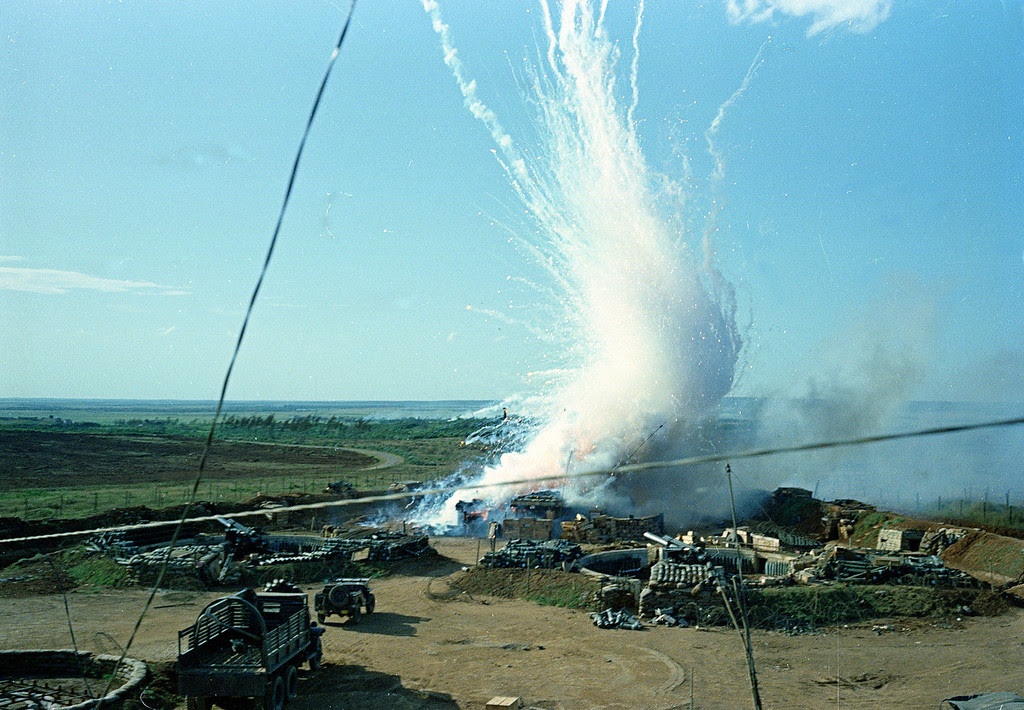 63
63 This general view shows a direct hit with North Vietnam 122 mm shell explosion in a U.S. ammunition bunker of 175 mm cannon emplacements at Gio Linh, next to demilitarization zone between north and south Vietnam, Sept. 1967, during the Vietnam War. (AP Photo)
Photo by Add this to feed 64
64 The address is muddy bunker and the mailman wears a flak vest as CPL. Jesse D. Hittson of Levelland, Texas, reaches out for his mail at the U.S. Marine Con Thien outpost two miles south of the demilitarized zone in South Vietnam on Oct. 4, 1967. (AP Photo/Kim Ki Sam)
Photo by Add this to feed 65
65 Anti-war demonstrators gather opposite the Lincoln Memorial in Washington, D.C., Oct. 21, 1967. In the background is the Reflecting Pool, the base of the Washington Monument, and barely visible through the haze is the Capitol Building. (AP Photo)
Photo by Add this to feed 66
66 Part of a crowd of pro-Vietnam War demonstrators hold up signs and American flags in support of U.S. policy in Vietnam in Wakefield, Mass., on Oct. 29, 1967. The demonstration was organized by 19-year-old Paul P. Christopher, a Wakefield high school senior who became "burned up" by anti-Vietnam War demonstrators. (AP Photo/J. Walter Green)
Photo by Add this to feed 67
67 Local members of the "Hell's Angels" motorcycle club form a human pyramid to wave flag and lead cheers at rally supporting American men fighting in Vietnam. A crowd estimated by police at near 25,000 turned out for the rally held this on October 29, 1967 on Wakefield, Massachusetts, common. (AP Photo/J Walter Green)
Photo by Add this to feed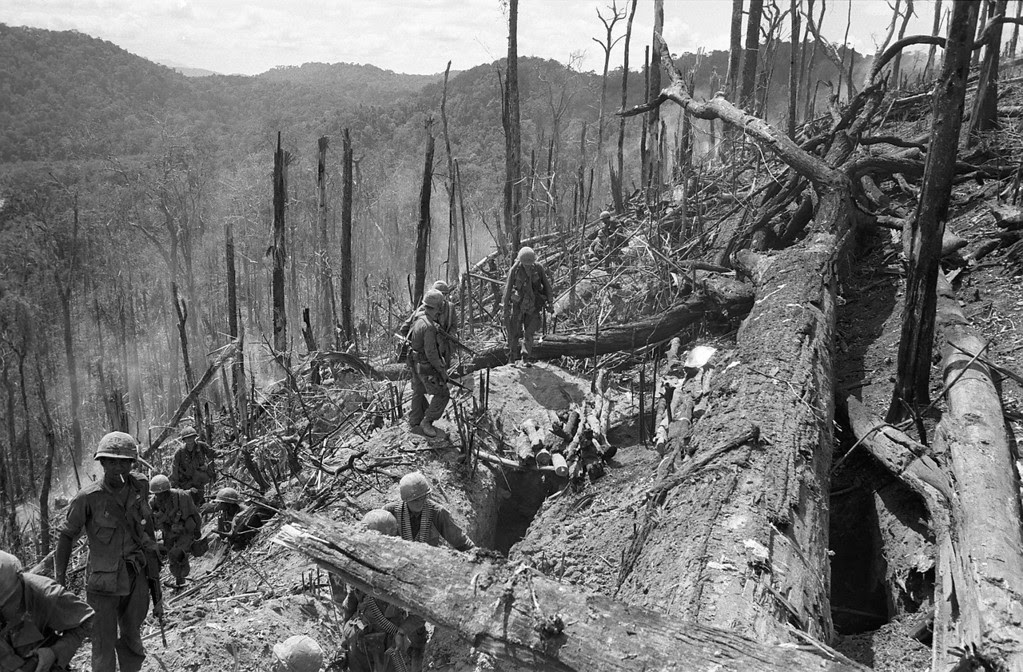 68
68 U.S. troops move toward the crest of Hill 875 at Dak To in November, 1967 after 21 days of fighting, during which at least 285 Americans were believed killed. The hill in the central highlands, of little apparent strategic value to the North Vietnamese, was nevertheless the focus of intense fighting and heavy losses to both sides. (AP Photo)
Photo by Add this to feed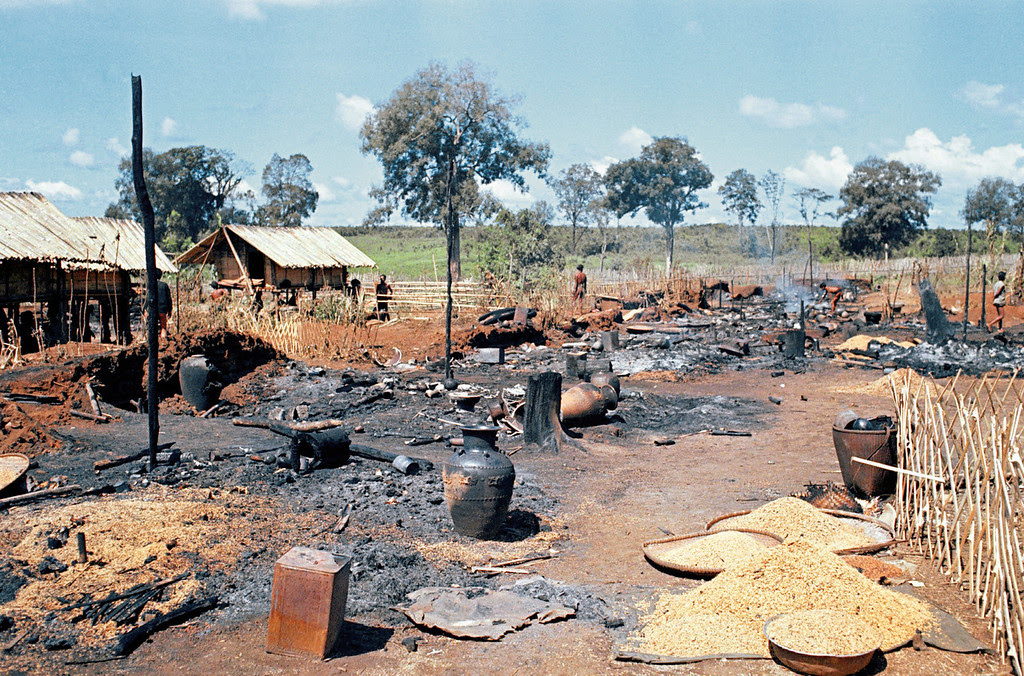 69
69 General views of the destroyed montagnards of Dak son new life Hamlet, December 7, 1967 in Vietnam. Vietcong killed 114 of the villagers and wounded 47. (AP Photo)
Photo by Add this to feed 70
70 More than 12,000 U.S. Marines crowd into an outdoor amphitheater to watch comedian Bob Hope and Phil Crosby open Hope's USO Christmas Show tour at Da Nang, Vietnam, with Raquel Welch and singer Barbara McNair, left, Dec. 19, 1967. Crosby, wearing a wig, carries a "Make Love Not War" sign. (AP Photo)
Photo by Add this to feed 71
71 U.S. Marines pass a Catholic church as they patrol near Danang, Vietnam, during the Vietnam War in 1968. (AP Photo)
Photo by Add this to feed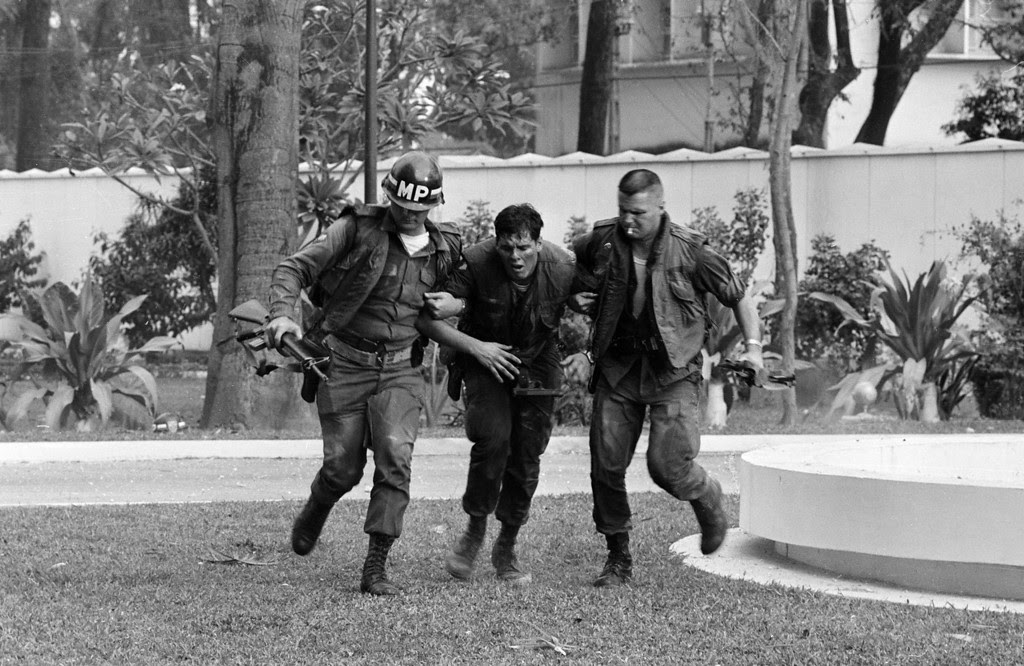 72
72 Two U.S. military policemen aid a wounded fellow MP during fighting in the U.S. Embassy compound in Saigon, Jan. 31, 1968, at the beginning of the Tet Offensive. A Viet Cong suicide squad seized control of part of the compound and held it for about six hours before they were killed or captured. (AP Photo/Hong Seong-Chan)
Photo by Add this to feed 73
73 South Vietnamese Gen. Nguyen Ngoc Loan, chief of the national police, fires his pistol into the head of suspected Viet Cong officer Nguyen Van Lem, also known as Bay Lop, on a Saigon street, early in the Tet Offensive on Feb. 1, 1968. (AP Photo/Eddie Adams)
Photo by Add this to feed 74
74 President Johnson prepares to open a news conference February 2, 1968 in the White House Cabinet room. He told reporters that the military phases of the Communist offensives in Vietnam had failed. (AP Photo)
Photo by Add this to feed 75
75 A large section of rubble is all that remained in this one block square area of Saigon on Feb. 5, 1968, after fierce Tet Offensive fighting. Rockets and grenades, combined with fires, laid waste to the area. An Quang Pagoda, location of Viet Cong headquarters during the fighting, is at the top of the photo. (AP Photo/Johner)
Photo by Add this to feed 76
76 First Lt. Gary D. Jackson of Dayton, Ohio, carries a wounded South Vietnamese Ranger to an ambulance Feb. 6, 1968 after a brief but intense battle with the Viet Cong during the Tet Offensive near the National Sports Stadium in the Cholon section of Saigon. (AP Photo/Dang Van Phuoc)
Photo by Add this to feed 77
77 A U.S. Marine shows a message written on the back of his flack vest at the Khe Sanh combat base in Vietnam on Feb. 21, 1968 during the Vietnam War. The quote reads, "Caution: Being a Marine in Khe Sanh may be hazardous to your health." Khe Sanh had been subject to increased rocket and artillery attacks from the North Vietnamese troops in the area. (AP Photo/Rick Merron)
Photo by Add this to feed 78
78 American soldiers take shelter in a sandbagged bunker as North Vietnamese rockets hit the U.S. Marine base at Khe Sanh on Feb. 24, 1968. (AP Photo/Rick Merron)
Photo by Add this to feed 79
79 An American C-123 cargo plane burns after being hit by communist mortars while taxiing on the Marine post at Khe Sanh, South Vietnam on March 1, 1968. (AP Photo/Peter Arnett)
Photo by Add this to feed 80
80 U.S. Air Force bombs create a curtain of flying shrapnel and debris barely 200 feet beyond the perimeter of South Vietnamese ranger positions defending Khe Sanh during the siege of the U.S. Marine base, March 1968. The photographer, a South Vietnamese officer, was badly injured when bombs fell even closer on a subsequent pass by U.S. planes. (AP Photo/ARVN, Maj. Nguyen Ngoc Hanh)
Photo by Add this to feed 81
81 Riverine assault boats, Operation of the Riverine Force of the U.S. 9th Division, glide along the My Tho River, an arm of the Mekong Delta near Dong Tam, 35 miles southwest of Saigon, Vietnam, March 15, 1968. (AP Photo)
Photo by Add this to feed 82
82 Bodies lay in the road leading from the village of My Lai, South Vietnam, following the massacre of civilians on March 16,1968.
Within four hours, 504 men, women and children were killed in the My Lai hamlets in one of the U.S. military's blackest days. (AP photo/FILE/Ronald L. Haeberle, Life Magazine)
Photo by Add this to feed 83
83 Police struggle with anti Vietnam War demonstrators outside the Embassy of the United States in Grosvenor Square, London, Mar. 17, 1968. (AP Photo)
Photo by Add this to feed 84
84 View of the Anti-Vietnam war demonstration held in Trafalgar Square, London, on March 17,1968. (AP Photo)
Photo by Add this to feed 85
85 U.S. President Lyndon B. Johnson addresses the nation in a radio and television broadcast from his desk at the White House in Washington, D.C., on March 31, 1968. In his speech the president talked about plans to de-escalate the war in North Vietnam and his plans not to run for re-election. (AP Photo)
Photo by Add this to feed 86
86 As fellow troopers aid wounded buddies, a paratrooper of A Company, 101st Airborne, guides a medical evacuation helicopter through the jungle foliage to pick up casualties during a five-day patrol of Hue, South Vietnam, in April, 1968. (AP Photo/Art Greenspon)
Photo by Add this to feed 87
87 Pfc. Juan Fordona of Puerto Rico, a First Cavalry Division trooper, shakes hands with U.S. Marine Cpl. James Hellebuick over barbed wire at the perimeter of the Marine base at Khe Sanh, South Vietnam, early April 1968. The meeting marked the first overland link-up between troops of the 1st Cavalry and the encircled Marine garrison at Khe Sanh. (AP Photo/Holloway)
Photo by Add this to feed 88
88 Air Cavalry troops taking part in Operation Pegasus are shown walking around and watching bombing on a far hill line on April 14, 1968 at Special Forces Camp at Lang Vei in Vietnam. (AP Photo/Richard Merron)
Photo by Add this to feed 89
89 Anti-Vietnam war protesters march down Fifth Avenue near to 81st Street in New York City on April 27, 1968, in protest of the U.S. involvement in the Vietnamese war. The demonstrators were en route to nearby Central Park for mass "Stop the war" rally. (AP Photo)
Photo by Add this to feed 90
90 Smoke rises from the southwestern part of Saigon on May 7, 1968 as residents stream across a bridge leaving the capital to escape heavy fighting between the Viet Cong and South Vietnamese soldiers. (AP Photo)
Photo by Add this to feed 91
91 This is a general view of the first meeting between the United States delegation, left, and North Vietnam delegation on the Vietnam peace talks at the international conference hall in Paris, May 13, 1968. (AP Photo)
Photo by Add this to feed 92
92 A supply helicopter comes in for a landing on a hilltop forming part of Fire Support Base 29, west of Dak To in South Vietnam's central highlands on June 3, 1968. Around the fire base are burnt out trees caused by heavy air strikes from fighting between North Vietnamese and American troops. (AP Photo)
Photo by Add this to feed 93
93 A helicopter full of Marines heading out on patrol lifts off the airstrip at the Khe Sanh combat base on June 27, 1968 in Vietnam. (AP Photo)
Photo by Add this to feed 94
94 U.S. 25th Infantry division troops check the entrance to a Vietcong tunnel complex they discovered on a sweep northwest of their division headquarters at Cu Chi on Sept. 7, 1968 in Vietnam. (AP Photo)
Photo by Add this to feed 95
95 A South Vietnamese woman mourns over the body of her husband, found with 47 others in a mass grave near Hue, Vietnam in April of 1969. (AP Photo/Horst Faas, File)
Photo by Add this to feed 96
96 At a hilltop firebase west of Chu Lai in Vietnam, a huge army "Chinook" helicopter prepares to lift a conked-out smaller one to a base for repairs, April 27, 1969. The firebase was named LZ West and was manned by the troopers of the 196th Light Infantry Brigade forming part of the American Division. The smaller helicopter - a Huey UH-ID - had developed engine trouble so its crew chief called in the local aerial towing service. One sturdy nylon strap to the chopper's winch and the two were off. (AP Photo/Oliver Noonan)
Photo by Add this to feed 97
97 A small boy holds his younger brother and looks at the remains of what was once his village, Tha Son, South Vietnam, 45 miles Northwest of Saigon, Vietnam on June 15, 1969. He and his family fled the village when Viet Cong troops infiltrated. Counter-attacking allied troops used artillery and bombs to push the Viet Cong out. The allies had told the people to leave their homes before the barrage began. (AP Photo/Oliver Noonan)
Photo by Add this to feed 98
98 A medic lights a cigarette for Spec/5 Gary Davies of Scranton, Pa., awaiting evacuation by helicopter from Ben Het in South Vietnam where he was wounded, June 27, 1969. (AP Photo/Oliver Noonan)
Photo by Add this to feed 99
99 Banners of appreciation from the Vietnamese decorate the dock at Danang where a farewell ceremony was held by the Vietnamese Government for departing Marines of the 1st Battalion/9th Regiment, July 14, 1969. (AP Photo)
Photo by Add this to feed 100
100 Some of the 300 troops of the 9th Infantry Division scheduled for departure from South Vietnam line up to board aircraft bound for Hawaii, August 27, 1969. (AP Photo)
Photo by Add this to feed 101
101 Supporters of the Vietnam moratorium lie in the Sheep Meadow of New York's Central Park Nov. 14, 1969 as hundreds of black and white balloons float skyward. A spokesman for the moratorium committee said the black balloons represented Americans who died in Vietnam under the Nixon administration, and the white balloons symbolized the number of Americans who would die if the war continued. (AP Photo/J. Spencer Jones)
Photo by Add this to feed 102
102 Vietnamese soldiers of the 21st Recon Company rush to board waiting Huey choppers in the rice paddies near their forward command post in South Vietnam on Nov. 14, 1969. The men are to be transported into the interior of the U-Minh forest, the large marshy and swamp and forest area at the southern tip of Vietnam, long considered to be a VC strong-hold. For the previous month, an all Vietnamese operation called "Operation u-minh" had been attempting to drive the VC and NVA regulars from the area. It was the second such operation within the year. (AP Photo/Godfrey)
Photo by Add this to feed 103
103 Demonstrators show their sign of protest as ROTC cadets parade at Ohio State University in May of 1970 during a ceremony in Columbus, Ohio during the Vietnam War. (AP Photo)
Photo by Add this to feed 104
104 Mary Ann Vecchio gestures and screams as she kneels by the body of a student lying face down on the campus of Kent State University, Kent, Ohio on May 4, 1970. National Guardsmen had fired into a crowd of demonstrators, killing four. (AP Photo/John Filo)
Photo by Add this to feed 105
105 Photographer Larry Burrows, far left, struggles through elephant grass and the rotorwash of an American evacuation helicopter as he helps GIs to carry a wounded buddy on a stretcher from the jungle to the helicopter in Mimot, Cambodia, May 4, 1970. The evacuation was during the U.S. incursion into Cambodia during the Vietnam War. (AP Photo/Henri Huet)
Photo by Add this to feed 106
106 American flag-bearing construction workers, angered by Mayor John Lindsay's apparent anti-war sympathies, lead hundreds of New York City workers supporting U.S. war policy in Vietnam in a demonstration inside a barricaded area near Wall Street in lower Manhattan, May 12, 1970. More than 1,000 police were on the scene to prevent possible clashes with anti-war student demonstrators, who were among office workers along the barricades. (AP Photo)
Photo by Add this to feed 107
107 With a helmet declaring "Peace," a soldier of the 1st Cavarly Division, 12th Cavalry, 2nd Battalion, relaxes June 24, 1970, before pulling out of Fire Support Base Speer, six miles inside the Cambodian border. The troops were returning to South Vietnam after operations against enemy sanctuaries in Cambodia. (AP Photo)
Photo by Add this to feed 108
108 Vietnam veterans opposed to the war assemble on the steps of the Capitol in Washington, April 19, 1971, to protest the U.S. action in Indochina. Addressing the crowd is Rep. Bella Abzug (D-NY), wearing hat. (AP Photo)
Photo by Add this to feed 109
109 John Kerry, 27-year-old former navy lieutenant who heads the Vietnam Veterans Against the War (VVAW), receives support from a gallery of peace demonstrators and tourists as he testifies before the Senate Foreign Relations Committee in Washington, D.C., April 22, 1971. (AP Photo/Henry Griffin)
Photo by Add this to feed 110
110 South Vietnamese troops move out on patrol from Firebase Fuller, a hilltop position four miles south of the demilitarized zone, Vietnam on July 20, 1971. (AP Photo/Jacques Tonnaire)
Photo by Add this to feed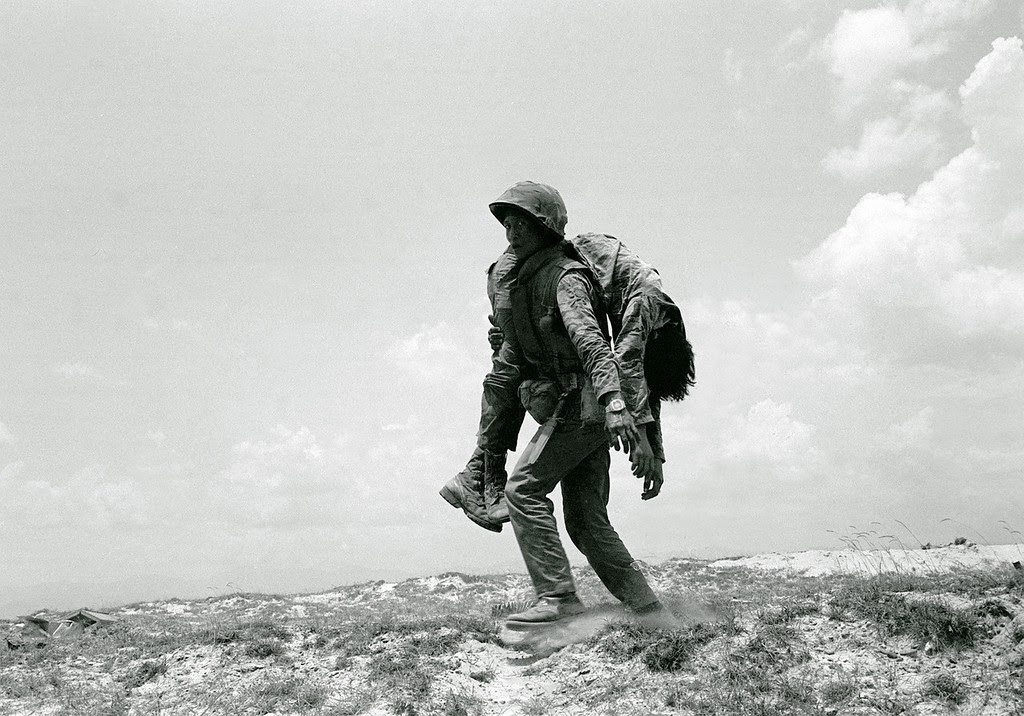 111
111 A South Vietnamese Marine carries the dead body of a comrade killed on Route 1, about seven miles south of Quang Tri Sunday, April 30, 1972. Marines were fighting to reopen the road in order to break the North Vietnamese siege of the provincial capital. (AP Photo/Koichiro Morita)
Photo by Add this to feed 112
112 South Vietnamese forces follow after terrified children, including 9-year-old Kim Phuc, center, as they run down Route 1 near Trang Bang after an aerial napalm attack on suspected Viet Cong hiding places on June 8, 1972. A South Vietnamese plane accidentally dropped its flaming napalm on South Vietnamese troops and civilians. The terrified girl had ripped off her burning clothes while fleeing. The children from left to right are: Phan Thanh Tam, younger brother of Kim Phuc, who lost an eye, Phan Thanh Phouc, youngest brother of Kim Phuc, Kim Phuc, and Kim's cousins Ho Van Bon, and Ho Thi Ting. Behind them are soldiers of the Vietnam Army 25th Division. (AP Photo/Nick Ut)
Photo by Add this to feed 113
113 South Vietnamese parents, with their five children, ride along Highway 13, fleeing southwards from An Loc toward Saigon on June 19, 1972. (AP Photo/Nick Ut)
Photo by Add this to feed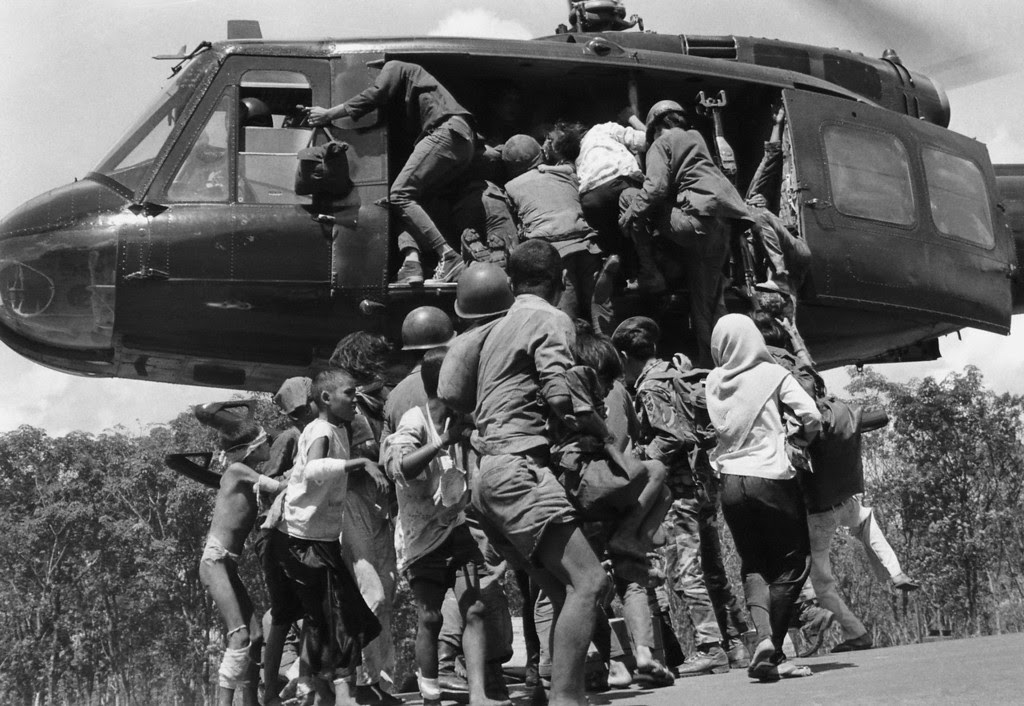 114
114 Lightly-wounded civilians and troops attempt to push their way aboard a South Vietnamese evacuation helicopter hovering over a stretch of Highway 13 near An Loc in Vietnam on June 25, 1972. (AP Photo)
Photo by Add this to feed 115
115 A line of South Vietnamese troops move along a devastated street in Quang Tri City as the battle continues for the provincial capital on July 28, 1972. Government forces were the midst of a campaign to retake the northern South Vietnamese city which was captured by enemy forces two months earlier. (AP Photo)
Photo by Add this to feed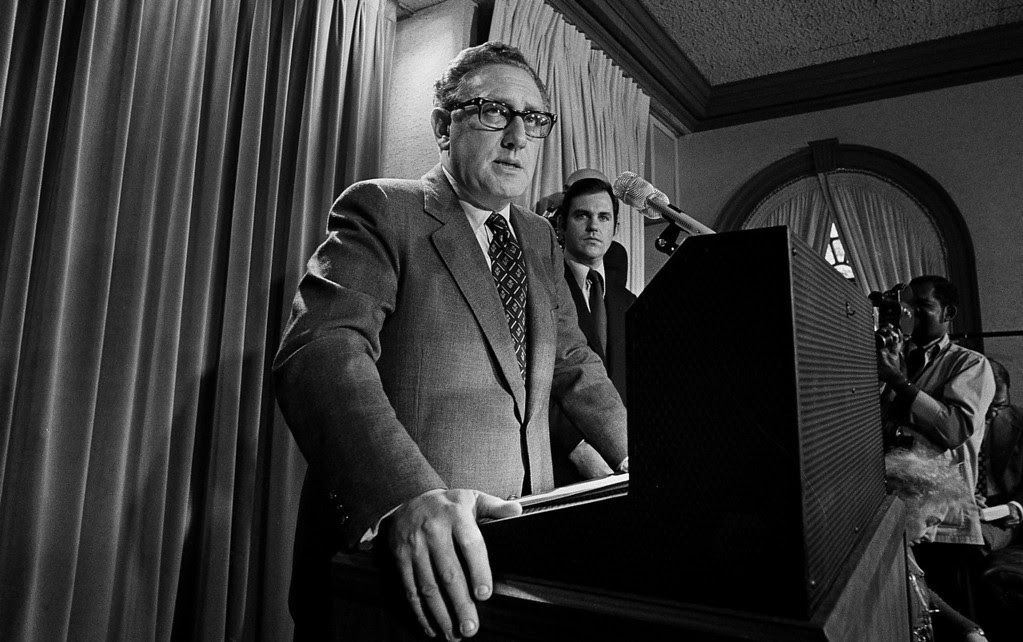 116
116 Then presidential adviser Dr. Henry Kissinger tells a White House news conference that "peace is at hand in Vietnam" on Oct. 26, 1972. (AP Photo)
Photo by Add this to feed 117
117 Police in Da Nang cover the eyes of a woman who was an alleged member of a Viet Cong terrorist unit on Oct. 26, 1972. The woman was captured carrying 15 hand grenades, during the previous night's battle in Da Nang. (AP Photo)
Photo by Add this to feed 118
118 The flag comes down at the U.S. Army base at Long Binn, 12 miles Northeast of Saigon, as the base is turned over to the South Vietnamese Army, Nov. 11, 1972. It was at one time the largest American base in Vietnam with a peak of 60,000 personnel in 1969. (AP Photo)
Photo by Add this to feed 119
119 Unaware of incoming enemy round, a South Vietnamese photographer made this picture of a South Vietnamese trooper dug in at Hai Van, South of Hue, Nov. 20, 1972. The camera caught the subsequent explosion before the soldier had time to react. The incident occurred during one of many continuing small scale fire fights in South Vietnam, despite talk of a forthcoming ceasefire. (AP Photo)
Photo by Add this to feed 120
120 President Nixon confers with Henry A. Kissinger in New York on Nov. 25, 1972, after the presidential adviser returned from a week of secret negotiations in Paris with North Vietnam's Le Duc Tho. Documents released Tuesday, Dec. 2, 2008, from the Nixon years shed new light on just how much the Nixon White House struggled with growing public unrest over the protracted war in Vietnam. (AP Photo)
Photo by Add this to feed 121
121 An American POW talks though a barred doorport to fellow POWs at a detention camp in Hanoi in 1973. (AP Photo)
Photo by Add this to feed 122
122 The four delegations sit at the table during the first signing ceremony of the agreement to end the Vietnam War at the Hotel Majestic in Paris, Jan. 27, 1973. Clockwise, from foreground, delegations of the Unites States, the Provisonal Revolutionary Government of South Vietnam, North Vietnam and South Vietnam. (AP Photo)
Photo by Add this to feed 123
123 John S. McCain III is escorted by Lt. Cmdr. Jay Coupe Jr., public relations officer, March 14, 1973, to Hanoi's Gia Lam Airport after the POW was released. (AP Photo/Horst Faas)
Photo by Add this to feed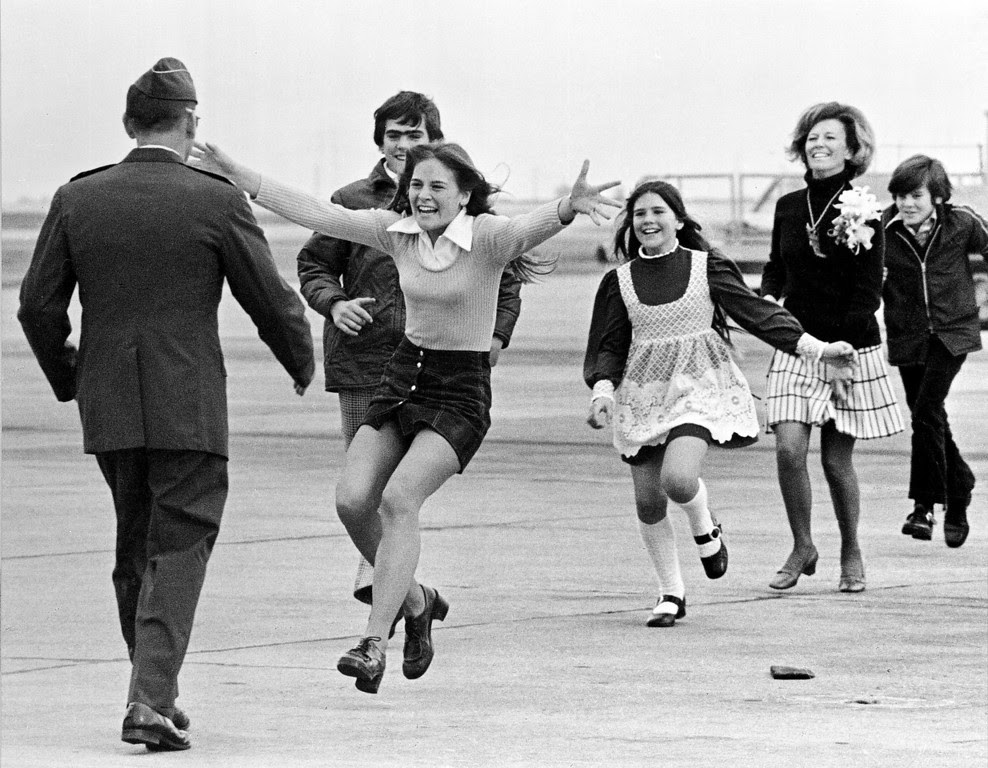 124
124 Released prisoner of war Lt. Col. Robert L. Stirm is greeted by his family at Travis Air Force Base in Fairfield, Calif., as he returns home from the Vietnam War, March 17, 1973. In the lead is Stirm's daughter Lorrie, 15, followed by son Robert, 14; daughter Cynthia, 11; wife Loretta and son Roger, 12. (AP Photo/Sal Veder)
Photo by Add this to feed 125
125 An iron door opens on a compound of the "Hanoi Hilton" prison, where the French once locked up political prisoners, shown March 18, 1973. When 33 Americans were freed from it days earlier, all the cells were empty for the first time in more than eight years. Journalists were allowed to visit the prison, located in downtown Hanoi days after it was emptied. (AP Photo/Horst Fass)
Photo by Add this to feed 126
126 A South Vietnamese soldier rests his eyes at a lonely outpost northeast of Kontum, 270 miles north of Saigon, March 25, 1974. The hill overlooks a vital North Vietnamese supply road and is located rear the scene of some of the bloodiest fighting in South Vietnam since the cease fire. The soldiers on the hill say the enemy is "all around them." (AP Photo/Nick Ut)
Photo by Add this to feed 127
127 Mrs. Evelyn Grubb, of Colonial Heights, Va., left, follows her husband Wilmers coffin at Arlington National Cemetery, Thursday, April 4, 1974, Washington, D.C. Col. Grubb's name was released by the Democratic Republic of Vietnam as one of the prisoners of war who died in captivity. Mrs. Grubb holds the hands of two of her sons, Roy, 7, right, and Stephen, 10. The rest of the group is unidentified. (AP Photo/Henry Burroughs)
Photo by Add this to feed 128
128 Riot police block path of hundreds of anti-government demonstrators who sought to parade from suburban Saigon to the city center on Thursday, Oct. 31, 1974. (AP Photo)
Photo by Add this to feed 129
129 A woman villager holding a small rock yells at a South Vietnamese military policeman on Feb. 10, 1975 during a confrontation near Hoa Hao in the Western Mekong Delta in Vietnam. Villagers had erected barricades along the highway to protest a government order disbanding the private army of a Buddhist sect in the area. (AP Photo)
Photo by Add this to feed 130
130 South Vietnamese troops fill every available space on a ship evacuating them from Thuan An beach, near Hue, to Da Nang as Communist troops advanced in March, 1975. (AP Photo/Cung)










































































































































































